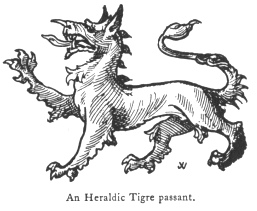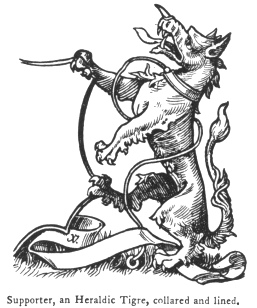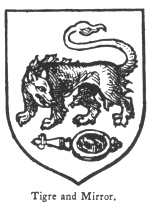
Masonic, Occult and Esoteric Online Library
Fictitious and Symbolic Creatures in Art
By John Vinycomb
Other Chimerical Creatures and Heraldic Beasts- The Heraldic Tigre or Tyger

"A savage tygress on her helmet lies;
The famous badge Clarinda us’d to wear."
Fairfax's "Tasso."
The tigre or tyger of the old heralds still holds its place in English armory, retaining the ancient name to distinguish it from the natural tiger, to which it bears but little resemblance except the name. The early artists probably had no better authority for the strange creature they depicted than the wild tales of Eastern travel and their own lively imaginations. The habit of drawing in a conventional manner may also have assisted in producing such a monster. This type of wild and ruthless ferocity, approaching the draconic in its power and destructiveness, was to their minds fitly suggested by exaggerations of those attributes of savageness and bloodthirstiness with which it was supposed to be endowed. Shakespeare makes King Henry V., when urging on his "noblest English" and "good yeomen" to the assault at Harfleur, declare that
"When the blast of war blows in our ears
Then imitate the action of the tiger;
Stiffen the sinews, summon up the blood,
Disguise fair Nature with hard-favoured rage."
"The tyger," says Bossewell, is a beast wonderful in strength,

and most swift in flight as it were an arrow. For the Persians call an arrow tygris. He is distinguished with diverse speckes; and of him the floode Tygris tooke the name. It is said Bacchus used these beastes in his chariot, for their marveilous swiftness in conveying of the same."
The heraldic tigre, the invention of the early heralds, is depicted as having the body similar to a wolf, but more strong and massive; powerful jaws armed with prominent canine tusks, and with a short curved horn or spike at the end of his nose. A row of knotted tufts of hair adorn the back of his neck as a mane; tufts also on his breast and thighs, and with strong claws; the tail of a lion completes his equipment. He is a most effective creature in a heraldic emblazonment, especially when "armed" and "tufted" of tinctures differing from his body.
The sinister supporter of the Marquess of Dufferin and Ava is an heraldic tigre ermine, gorged with a tressure flory counter flory or.
Gules a chevron argent, between three tigres, &c., of the second.—Butler, Calais.
Vert, a tigre passant or, maned and tufted argent.—Love, Norfolk (granted 1663).
Or, a tigre passant gules.—Lutwych, Lutwich, Salop.
Baron Harlech has for dexter supporter, and also for crest, an heraldic tigre argent, maned and tufted sable.
The tigre and mirror is an uncommon but very remarkable bearing. Amongst other remarkable ideas which our ancestors entertained respecting foreign animals, "some report that those who rob the tigre of her young use a policy to detaine their damme from following them by casting sundry looking-glasses in the way, whereat she useth to long to gaze, whether it be to beholde her owne beauty or because when she seeth her shape in the glasse she thinketh she seeth one of her young ones; and so they escape the swiftness of her pursuit." *
"Argent, a tigre passant regardant looking into a mirror lying fessways, the handle to the dexter all proper,"

is said to have been the coat of Hadrian de Bardis (probably an Italian), Prebendary of Oxfordshire. These arms still remain, or were lately remaining, in a window of Thame Church. Only two other examples occur, viz.:
"Argent a tigre and mirror (as before) gules."—Sibell, Kent.
Footnotes
193:* Guillam's "Display of Heraldry." The same is also related in the Latin "Bestiarium," Harl. MSS. 4751; and by Albertus Magnus, Camerarius, &c.
